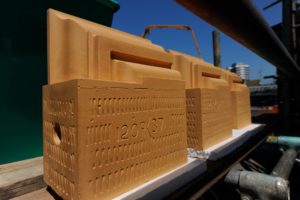Services Spotlight: Terracotta
Stonewest NewsServices Spotlight: Terracotta

We have been working with Terracotta throughout our company history. This durable material is both economically and practically viable – we frequently use, repair and build with it. After identifying Terracotta defects and understanding their causes, we develop the most appropriate conservation and preservation strategies which include consolidation, repair or possible replacement. We then work with specialist suppliers to reproduce matching profiles, colours and finishes to enable replacement units to be procured for the building or structure. Below we explore the history, benefits and challenges involved. For further information or advice about Terracotta, please contact our technical team who will be happy to help.
History in design
Terracotta is colourful, decorative and can be applied in a wide and innovative range of buildings and styles. Historically, it was often used as an integral part of a building’s facade to replace painted signs and for sculptural decoration. Decorative forms of Terracotta were dictated by style trends towards the end of the 19th Century and all its uses were concerned with improvement of the environment of the industrial city. Architects employed it in unrestricted designs for precisely realised effects, and it became a badge of civic pride in areas of production.
As J. Doulton once said: “That class of ware… of a higher class than ordinary bricks, demanding more care in the choice of the clay and much harder firing, and being consequently, more durable and better fitted for moulded and decorative work”.
Benefits
Almost exclusively and originally used as an urban building material, there are numerous benefits to working and building with Terracotta. At one time it was considered inexpensive compared to natural stone, but nowadays can be expensive. From a practical perspective, this material is fire and pollution resistant to a degree, as well as durable with a long in-service life. This material can have a smooth or lightly textured, dirt-resistant fired surface, is strong in compression, easily standardised and repeated, plus it is light and easily transported.
Deterioration
The challenges we face make more sense when we consider the key causes of deterioration in Terracotta. The principal cause is water penetration. Although the glaze or ‘fire skin’ of Terracotta is normally highly impervious, the clay body beneath will absorb water easily. Once the fire skin is lost through abrasion, erosion or impact damage, water can enter and deterioration will occur.
As well as this, freeze thaw action from retention of moisture can compromise the fire skin and crack the units. Fungi, mould and algae can also cause biological deterioration, for example, by penetrating and creeping beneath the fire skin. Inappropriate cleaning can also compromise the material and lead to further damage. In addition, general water penetration through the porous mortar joints can lead to corrosion and expansion of ferrous fixings and thereafter mechanical damage.
Finally, inappropriate cementitious mortar repairs (which do not allow moisture transmission) will also retain captured moisture between the parent material and the dense repair mortar layers, which encourages freeze thaw action and mechanical damage to the Terracotta. As dense impervious mortars fail, these materials often damage the original historic material leaving it friable and prone to accelerated decay.
These issues are taken into account when deciding whether a Terracotta unit can be repaired in situ or must be replaced when it has lost cohesive strength and weathering performance.
Procurement
Today, when working with this versatile material, we must overcome a number of challenges involved, particularly when there are few contractors that know how to correctly repair, replicate, use and build with Terracotta. For example, this material can be costly, with a protracted procurement period and long drying time in production. Manufacturers are few and hand profiling and finishing requires specialised skills. Colour matching to original existing material is challenging, while detailing is difficult to repeat and requires individual moulds for individual blocks. Maquettes are also often required for sculpted elements of design. Fortunately, these challenges can be managed with the right skills.
Expertise
Terracotta is a unique and durable material that delivers a stunning, stand-out finish. With the right expertise, its challenges will be overcome to ensure its longevity and beauty remains. As a team, we are highly skilled and trained in working with Terracotta. Our past projects range in size from fountains to entire facades, including the London Coliseum, Victoria Palace Theatre, Harrods and Dunorlan Park in Tunbridge Wells.
Our technical team is on hand to discuss any of your project needs. To get in touch, please call our Head Office on 020 8684 6646 or email us on info@stonewest.co.uk




